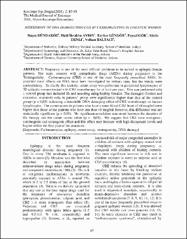| dc.contributor.author | Dündaröz, Ruşen | |
| dc.contributor.author | Aydın, Halil İbrahim | |
| dc.contributor.author | Güngör, Tayfun | |
| dc.contributor.author | Gök, Faysal | |
| dc.contributor.author | Denli, Metin | |
| dc.contributor.author | Baltacı, Volkan | |
| dc.date | 2015-01-19 | |
| dc.date.accessioned | 2015-01-19T12:42:38Z | |
| dc.date.available | 2015-01-19T12:42:38Z | |
| dc.date.issued | 2001-01 | |
| dc.identifier.issn | 1302-4612 | |
| dc.identifier.uri | http://hdl.handle.net/11630/1587 | |
| dc.description.abstract | Pregnancy is one of the most difficult problems to be solved in epileptic female patients. The main concern with antiepileptic drugs (AEDs) during pregnancy is the Teratogenicity. Carbamazepine (CBZ) is one of the most frequently prescribed AEDs. Its potential toxic effects on DNA have been investigated by various tests, but the results were contradictory. To clarify this toxicity, comet assay was performed in peripheral lymphocytes of 32 epileptic women treated with CBZ monotherapy for at least one year. This was performed with a control group that included 16 and non-drug using healthy females. The damaged (limited and extensive, migrated) cells in patients’ group were significantly higher than that of the control group (p < 0,05) indicating a detectable DNA damaging effect of CBZ monotherapy on human lymphocytes. The comet scores in patients who have a mean blood CBZ level of >8 mcg/ml were higher than those of the patients who have less than <8 mcg/ml; however, this difference was not statistically significant (p > 0,05). No significant correlation was noted between the duration of the therapy and the comet scores either (p > 0,05). We suggest that CBZ have mutagenic, carcinogenic and teratogenic effect and this effect may increase with high therapeutic levels and begins within the first year of the treatment. | en_US |
| dc.description.abstract | Epileptik kadın hastalarda gebelik, çözülmesi en zor problemlerden biridir. Gebelik sırasındaki antiepileptik ilaçlar (AED'ler) ile ilgili ana endişe Teratojenite'dir. Karbamazepin (CBZ) en sık reçete edilen AED'lerden biridir. DNA üzerindeki potansiyel toksik etkileri çeşitli testlerle araştırılmıştır, ancak sonuçlar çelişkilidir. Bu toksisiteyi açıklığa kavuşturmak için, CBZ monoterapisi ile tedavi edilen 32 epileptik kadının periferal lenfositlerinde en az bir yıl boyunca kuyruklu yıldız analizi yapıldı. Bu, sağlıklı dişi kullanan 16 ve uyuşturucu olmayan kontrol grubu ile yapıldı. Hasta grubundaki hasarlı (sınırlı ve geniş, göç eden) hücreler, CBZ monoterapisinin insan lenfositleri üzerindeki tespit edilebilir bir DNA hasar etkisine işaret eden kontrol grubundan (p <0,05) anlamlı derecede yüksekti. Kan CBZ düzeyi> 8 mcg / ml olan hastalarda kuyruklu yıldız skorları <8 mcg / ml'den düşük olanlara göre daha yüksekti; ancak bu fark istatistiksel olarak anlamlı değildi (p> 0,05). Terapi süresi ile kuyruklu yıldız puanları arasında da anlamlı bir ilişki bulunmadı (p> 0,05). CBZ'nin mutajenik, kanserojen ve teratojenik etkiye sahip olduğunu ve bu etkinin yüksek terapötik düzeylerde artabileceğini ve tedavinin ilk yılında başladığını öne sürüyoruz. | |
| dc.language.iso | eng | en_US |
| dc.publisher | Afyon Kocatepe Üniversitesi, Kocatepe Tıp Dergisi | en_US |
| dc.rights | info:eu-repo/semantics/openAccess | en_US |
| dc.subject | Carbamazepine | en_US |
| dc.subject | Epilepsy | en_US |
| dc.subject | Comet Assay | en_US |
| dc.subject | Teratogenicity | en_US |
| dc.subject | DNA Damage | en_US |
| dc.title | Assessment of DNA damage induced by carbamazepine in epileptic women | en_US |
| dc.title.alternative | Epileptik kadınlarda karbamazepinin neden olduğu DNA hasarının değerlendirilmesi | en_US |
| dc.type | article | en_US |
| dc.relation.journal | Afyon Kocatepe Üniversitesi, Kocatepe Tıp Dergisi | en_US |
| dc.department | Afyon Kocatepe Üniversitesi | en_US |
| dc.identifier.volume | 2 | en_US |
| dc.identifier.startpage | 87 | en_US |
| dc.identifier.endpage | 93 | en_US |
| dc.identifier.issue | 1 | en_US |
| dc.relation.publicationcategory | Makale - Ulusal Hakemli Dergi - Kurum Yayını | en_US |



















